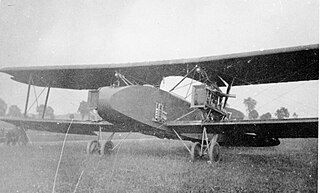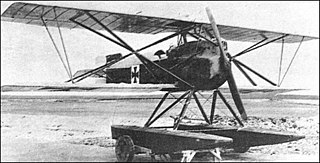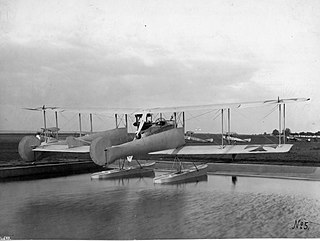
The Albatros G.III, was a German bomber aircraft development of World War I. It was a large, single-bay biplane of unequal span and unstaggered wings. Power was provided by two Benz Bz.IVa pusher engines installed in nacelles carried between the wings. An unusual feature of the design was that the lower wing was provided with cutouts for the propellers, allowing the engine nacelles to be mounted further forward than would have been otherwise possible. Few were built, these seeing service mostly on the Macedonian Front in 1917.

The Albatros J.II was a German single-engine, single-seat, biplane ground-attack aircraft of World War I.

The Albatros G.II,, was a twin-engined German biplane bomber of World War I.

The Alabatros W.5 was a floatplane torpedo bomber used by Germany during World War I. It was a biplane with twin pusher engines.

The Hansa-Brandenburg KDW was a German single-engine, single-seat, fighter floatplane of World War I. The KDW – Kampf Doppeldecker, Wasser – was adapted from the Hansa-Brandenburg D.I landplane to provide coastal defence over the North Sea.

The Friedrichshafen G.I was a prototype heavy bomber aircraft that was built in Germany by Flugzeugbau Friedrichshafen in 1915. It was Karl Gehlen's first design for the company, and although it was not produced in quantity, it provided the foundation for the later, highly successful bombers culminating in the G.III.

The Friedrichshafen G.II was a heavy bomber aircraft that was designed and manufactured in Germany during World War I by Flugzeugbau Friedrichshafen. The plane was used by the Luftstreitkräfte for tactical and limited strategic bombing operations.

The Hansa-Brandenburg CC was a single-seat German fighter flying boat of World War I. It was used by both the Kaiserliche Marine and the Austro-Hungarian Navy.

The Friedrichshafen FF.35 was a German three-seat floatplane torpedo bomber built during World War I by Friedrichshafen Flugzeugbau built for the Imperial German Navy's Naval Air Service. Only one prototype was constructed in 1916 and it saw limited operational use during the war in Courland.

The Gotha WD.3 was a prototype maritime reconnaissance floatplane developed during World War I by Gothaer Waggonfabrik (Gotha) for the Imperial German Navy's Naval Air Service. The three-seat aircraft used the pusher configuration with the engine behind the crew. It was lacking in performance compared to aircraft with the more common tractor configuration with the engine in the nose and was not approved for production. The single prototype completed was used as a training aircraft; its ultimate fate is unknown.

The Gotha WD.7 was a twin-engine maritime patrol and torpedo-bomber training floatplane developed during World War I by Gothaer Waggonfabrik for the Imperial German Navy's Naval Air Service. The WD.8 was a single-engine version of the WD.7 developed for comparative purposes. The single aircraft built was deemed "totally unsuitable" by the Naval Air Service and was later sold to the Ottoman Empire.

The Gotha WD.14, WD.20, and WD.22 were a family of biplane torpedo bomber floatplanes developed in Germany during World War I.

The Zeppelin-Staaken Riesenflugzeuge were a series of very large bomber aircraft - Riesenflugzeuge, usually powered by four or more engines, designed and built in Germany from 1915 to 1919.

The Otto C.I, also known as the Otto KD.15, was a German two-seat biplane reconnaissance and bomber aircraft of the First World War designed and produced by Otto Flugmaschinenfabrik. The C.I was a rare example of an aircraft flown by the Central Powers which had a pusher configuration.

The Albatros W.8 was a German biplane fighter floatplane that saw service during First World War. It patrolled the seas around 1918. The fuselage of the aircraft was made of wood, similar to most aircraft designs of that period. The W.8 had a water-cooled Benz Bz.IIIb eight-cylinder engine fitted with a fixed two-bladed wooden propeller.

The LFG Roland G.I was a large prototype single-engine biplane bomber built in Germany in 1915, during World War I. It had a single engine buried in the fuselage driving pusher configuration propellers mounted on outriggers.

The Schütte-Lanz G.I was a large, twin engine, pusher configuration, experimental biplane built in Germany early in World War I. Only one was completed.

The Albatros C.XIV was a German two seat, single engine, biplane fighter aircraft built in 1918. Only one was constructed.

The Hansa-Brandenburg W.18 was a single-seat German fighter flying boat of World War I. It was used by both the Kaiserliche Marine and the Austro-Hungarian Navy.

The Hansa-Brandenburg W.25 was a German floatplane fighter of the World War I era, designed and built by Hansa-Brandenburg.




















